
Turkish Journal of Anaesthesiology and Reanimation
Scope & Guideline
Inspiring Excellence in Anesthesia Research and Practice.
Introduction
Aims and Scopes
- Clinical Anaesthesiology:
Research on various anaesthetic techniques, including general and regional anaesthesia, focusing on their efficacy, safety, and patient outcomes. - Perioperative Care:
Studies addressing the management of patients before, during, and after surgery, emphasizing fluid management, pain control, and enhanced recovery protocols. - Anaesthetic Pharmacology:
Investigations into the pharmacological aspects of anaesthetic agents, including their effects on physiological parameters and interactions with other medications. - Innovative Techniques and Technologies:
Exploration of new technologies and techniques in anaesthesia, such as ultrasound-guided procedures and advanced monitoring methods. - Patient Safety and Quality Improvement:
Research dedicated to improving safety in anaesthesia practice, including studies on complications, risk management, and adherence to safety protocols. - Educational Aspects in Anaesthesia:
Studies related to the training and education of anaesthesiologists and residents, including simulation-based learning and competency assessments.
Trending and Emerging
- Regional Anaesthesia Techniques:
There is a growing emphasis on the use of regional anaesthesia techniques, such as the Erector Spinae Plane Block, reflecting a trend towards minimizing opioid use and improving postoperative pain management. - Perioperative Patient Optimization:
Research exploring preoperative optimization strategies, including nutrition and prehabilitation, is increasing, highlighting a focus on improving overall surgical outcomes. - Impact of COVID-19 on Anaesthesia Practice:
The pandemic has led to a surge in studies examining the implications of COVID-19 on anaesthesia practices, including safety protocols, management of COVID-positive patients, and the psychological impact on healthcare workers. - Multimodal Analgesia Approaches:
An emerging focus on multimodal analgesia strategies indicates a shift towards comprehensive pain management solutions that reduce reliance on opioids. - Technological Integration in Anaesthesia:
The integration of technology in anaesthesia practice, including the use of artificial intelligence and telemedicine, is gaining attention as a means to enhance patient safety and care quality.
Declining or Waning
- Traditional Anaesthetic Techniques:
There has been a noticeable decrease in studies focusing on conventional anaesthetic methods as the field moves towards more innovative and technology-driven approaches. - Basic Monitoring Techniques:
Research on standard monitoring techniques has declined, possibly due to the adoption of more advanced monitoring technologies and practices. - Complications Related to General Anaesthesia:
While still an important topic, the frequency of studies specifically addressing complications from general anaesthesia appears to be decreasing in favor of broader perioperative care topics. - Historical Studies in Anaesthesia:
Research focusing on the historical aspects of anaesthesia, including retrospective analyses, is becoming less prominent as the journal emphasizes contemporary practices and innovations.
Similar Journals
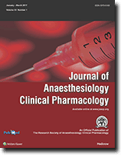
Journal of Anaesthesiology Clinical Pharmacology
Leading the Way in Anesthesia and Clinical PharmacologyJournal of Anaesthesiology Clinical Pharmacology, a distinguished publication by Wolters Kluwer Medknow Publications, is at the forefront of advancing knowledge in the fields of anesthesiology, clinical pharmacology, and pain medicine. Since its inception, this Open Access journal has committed itself to disseminating high-quality research and reviews that cater to the evolving needs of professionals, researchers, and students worldwide. With an ISSN of 0970-9185 and an E-ISSN of 2231-2730, this journal serves as a significant platform for sharing innovations and clinical practices within its scope. Notably, it holds a Q3 ranking in Anesthesiology and Pain Medicine and a Q2 ranking in Pharmacology, Toxicology, and Pharmaceutics (miscellaneous), reflecting its impactful contributions to the scientific community. Published in India, the journal has evolved from its converged years of 1996 to 1999 and from 2002 to 2024 to become a recognized source of expertise in clinical pharmacology. Its Scopus rankings underscore its commitment to quality, placing it within the competitive landscape of medical literature. Explore cutting-edge studies and clinical insights as you engage with a journal dedicated to the optimal management of anesthesia and pain therapies.
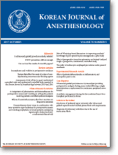
Korean Journal of Anesthesiology
Pioneering Progress in Pain MedicineKorean Journal of Anesthesiology, published by the Korean Society of Anesthesiologists, stands as a premier platform for advancing the field of anesthesiology and pain medicine. Since 1968, this open access journal has fostered a rich exchange of knowledge, contributing to its esteemed Q1 category ranking in 2023, which highlights its impactful contributions among its peers. With the Scopus ranking of #25 out of 136 in anesthesiology and a commendable 81st percentile, the journal aims to bridge the gap between research and clinical practice by publishing innovative research, comprehensive reviews, and case reports. Based in South Korea, it serves as a vital resource for researchers, medical professionals, and students dedicated to the enhancement of patient care and advancements in anesthesiology practice. As it converges its efforts through 2024 and beyond, the journal remains committed to disseminating high-quality research that shapes the future of anesthetic science.
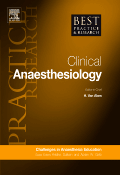
Best Practice & Research-Clinical Anaesthesiology
Elevating patient care with best practices in anesthesia.Best Practice & Research-Clinical Anaesthesiology is a prestigious peer-reviewed journal published by Elsevier, dedicated to advancing the field of anesthesiology and pain medicine. With an ISSN of 1521-6896 and an impressive impact factor, this journal is categorized in the top quarter (Q1) of its field, reflecting its high-quality research and influence. Since its inception, the journal has served as a key resource for clinicians, researchers, and students by providing insightful articles on the latest techniques, best practices, and evidence-based approaches in clinical anesthesiology. Although the journal's coverage in Scopus has been discontinued, its ongoing contributions remain vital to the discourse surrounding anesthesia practice and patient care. As the landscape of anesthesia evolves, Best Practice & Research-Clinical Anaesthesiology continues to publish thought-provoking content that informs and inspires professionals in their pursuit of excellence in the operating room and beyond.

Saudi Journal of Anaesthesia
Transforming Anaesthesiology: Where Research Meets CareSaudi Journal of Anaesthesia, published by Wolters Kluwer Medknow Publications, is a premier open-access journal dedicated to the field of anaesthesiology and pain medicine. Established in 2009, it serves as a vital resource for clinicians, researchers, and students, providing a platform for the dissemination of high-quality research and clinical studies. With an impact factor that positions it in the Q3 category of anesthesiology and pain medicine, the journal ranks at #71 out of 136 in Scopus, reflecting its growing influence and reach in the academic community. Based in India, the journal's objectives include the promotion of innovative research, advancements in clinical practice, and the sharing of knowledge that significantly contributes to the field. The journal's open-access format ensures that its valuable insights are readily available to professionals worldwide, fostering collaboration and enhancing the quality of patient care.
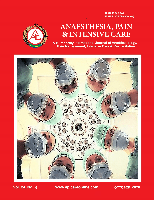
Anaesthesia Pain & Intensive Care
Advancing knowledge in anesthesiology and critical care.Anaesthesia Pain & Intensive Care is an esteemed, open-access journal that has been at the forefront of disseminating pivotal research since 1999. Published by ANAESTHESIA PAIN & INTENSIVE CARE, this journal focuses on the critical fields of anesthesiology, pain management, and intensive care medicine, engaging a diverse audience of researchers, healthcare professionals, and students. Operating from Islamabad, Pakistan, it aims to foster knowledge exchange and innovative practices within its community. With a reputation indexed in Scopus and categorized in the fourth quartile for both anesthesiology and critical care, the journal provides a platform for emerging ideas and findings, inviting contributions that enhance the global discourse in these vital areas of medicine. For those seeking to stay at the forefront of clinical advancements, Anaesthesia Pain & Intensive Care is a valuable resource, promoting open access to ensure that critical information is available to all stakeholders.

Canadian Journal of Anesthesia-Journal canadien d anesthesie
Advancing Anesthesia: Pioneering Research for Pain ManagementThe Canadian Journal of Anesthesia - Journal canadien d anesthésie, published by Springer, stands as a premier peer-reviewed publication in the field of anesthesiology and pain medicine, making significant contributions to the advancement of clinical practices and research since its inception in 1987. With an impressive impact factor and consistently ranked in the Q1 category for both anesthesiology and miscellaneous medicine, this journal is recognized for its high-caliber research, positioning it within the top 10 in its category according to Scopus rankings. The journal aims to disseminate innovative findings, clinical methodologies, and review articles that inspire advances in the management of anesthesia and pain, making it an invaluable resource for researchers, practitioners, and students worldwide. While it does not currently offer Open Access options, the journal’s comprehensive studies and expert insights continue to attract a vast readership eager to enhance their knowledge in these critical medical fields.

Journal of Obstetric Anaesthesia and Critical Care
Innovating practices for optimal maternal and neonatal outcomes.Journal of Obstetric Anaesthesia and Critical Care, published by Wolters Kluwer Medknow Publications, is a premier Open Access journal dedicated to the field of obstetric anaesthesia and critical care medicine. Since its inception in 2011, this journal has become a vital resource for researchers, clinicians, and students, offering a platform for the dissemination of cutting-edge research, reviews, and innovative practices that enhance the safety and efficacy of obstetric anaesthetic care. With an ISSN of 2249-4472 and an E-ISSN of 2249-9539, the journal provides unrestricted access to its published content, promoting knowledge sharing across the global medical community. Readers can expect articles covering a wide range of topics, including but not limited to, regional anaesthesia techniques, patient safety protocols, and perioperative management in obstetric patients. The Journal of Obstetric Anaesthesia and Critical Care holds significant value in its field, contributing to improved patient outcomes and advancing the scope of anaesthetic practice.
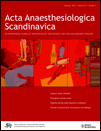
ACTA ANAESTHESIOLOGICA SCANDINAVICA
Empowering Practitioners with Peer-Reviewed Anesthetic ResearchACTA ANAESTHESIOLOGICA SCANDINAVICA, published by Wiley, is a leading journal in the field of anesthesiology and pain medicine, boasting an impressive impact factor evident by its Q1 classification in 2023. As a highly respected publication with a history dating back to 1957 and continuing through to 2024, it serves as a vital platform for researchers and practitioners in Denmark and worldwide to disseminate significant findings and innovative practices in anesthetic techniques and pain management. The journal holds a commendable rank of #45 out of 136 in the Scopus category for Anesthesiology and Pain Medicine, positioning it within the 67th percentile, underlining its substantial contribution to the scientific community. Although not an Open Access journal, ACTA ANAESTHESIOLOGICA SCANDINAVICA remains pivotal for academics and healthcare professionals keen on advancing the field through peer-reviewed research and insightful reviews. Researchers and scholars are encouraged to submit their original studies and reviews to continue enriching this prestigious journal’s commitment to excellence in anesthesiology.
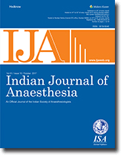
Indian Journal of Anaesthesia
Unlocking Insights in Anesthesia and Pain MedicineIndian Journal of Anaesthesia, published by Wolters Kluwer Medknow Publications, is a premier peer-reviewed journal dedicated to the field of anesthesiology and pain medicine. With an impressive impact factor and a current ranking of #46/136 in its category, this journal is classified in the Q2 quartile for the year 2023, indicating its significant contribution to scholarly research. Since transitioning to an Open Access model in 2002, the journal has made strides in increasing the accessibility of critical research and practices in anesthesia. Its extensive coverage includes contemporary issues in anesthetic techniques, pain management strategies, and advancements in clinical practices. As it converges years from 2010 to 2024, the Indian Journal of Anaesthesia remains an essential resource for professionals, researchers, and students seeking high-quality, evidence-based content that fosters knowledge sharing and advancement in this vital medical specialty.

ANASTHESIOLOGIE & INTENSIVMEDIZIN
Exploring the Frontiers of Pain Management and CareANASTHESIOLOGIE & INTENSIVMEDIZIN is a peer-reviewed journal dedicated to the fields of anesthesiology, critical care, and intensive medicine. Published by AKTIV DRUCK & VERLAG GMBH in Germany, this journal has been an essential resource in the medical community since its inception in 1978. With a current impact factor placing it in the Q3 quartile in both anesthesiology and critical care categories, it serves as a platform for disseminating cutting-edge research and innovative practices. The journal invites contributions that enhance the understanding of pain management, perioperative care, and intensive treatment methodologies. Although not open access, it remains committed to advancing knowledge and improving patient outcomes. With a strong focus on practical applications, ANASTHESIOLOGIE & INTENSIVMEDIZIN is invaluable for researchers, clinical practitioners, and students seeking to deepen their expertise in these crucial areas of healthcare.